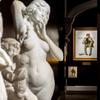Out of This World: Antique Telescopes
- July 19, 2011 10:30
When was the last time you went outside on a clear night for the sole purpose of looking at the night sky? I sometimes wonder about the level of amazement that must have gone through the minds of early man, observing comets, eclipses and moon phases with a surreal combination of awe and trepidation. These first “astronomers” used what they observed with the naked eye to explain everything from the changing seasons to their religious beliefs. But it wasn’t until the invention of the telescope that these observations made the giant leap from mere assumption to revolutionary truth.
The first mention of an operating telescope occurred in 1608. Hans Lippershey, a lens maker from the Netherlands, discovered that if you take two lenses, spaced them apart and look through them, the object viewed got bigger. A mere four months later, Galileo Galilei took the next steps to improving and perfecting models based on Lippershey’s discovery. Suddenly, it was possible to see the craters of the moon and spots on the sun. Unfortunately, Galileo spent much of his career at odds with the Church for some of his discoveries, spending the last decade of his life under house arrest. But the ball had already been set into motion, and other opticians and scientists for years to come jumped at the chance to take the telescope to new heights.
One such man was Parisian optician Robert-Aglae Cauchoix, who created this Monumental Telescope. Creator of three of the largest telescopes of his day, it is possible that this magnificent masterpiece may have been the telescope made for the famed Paris Observatory. Crafted of brass, this refracting telescope measures over seven feet in length and is mounted upon a complex “catapult” base that gives it an incredible range of motion. It even comes with its original case of immense interchangeable lenses that measure over a half-foot in diameter!
This telescope would be perfect to view some fantastic astronomical events occurring within the next several weeks:
• July 28–29 is the Southern Delta Aquarids Meteor Shower, which can produce about 20 meteors per hour at their peak. The showers usually peak on July 28 and 29, but some meteors can also be seen from July 18–August 18.
• Neptune will be at opposition on August 11. The blue planet will be at its closest approach to Earth and its face will be fully illuminated by the Sun, which is the best time to view Neptune.
• From August 12–13, the grand Perseids Meteor Shower is known for producing up to 60 meteors per hour at their peak. The shower's peak usually occurs on August 13 & 14, but you may be able to see some meteors any time from July 23 - August 22.
I hope you have the chance to see these most magnificent of nature’s spectacles for yourself…with the right antique telescope, of course!
To view M.S. Rau Antiques selection of Medical and Scientific Instruments, click here.






100x100_n.jpg)
100x100_c.jpg)













